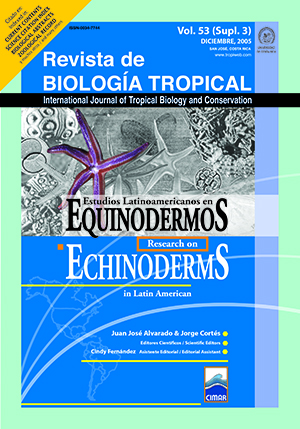Abstract
In the Magellan Region of southern Chile (52°20’S- 55°30’S), the edible urchin Loxechinus albus is collected by 1 200 artisanal fishermen, of whom 450 are divers. About 360 small fishing boats and 54 transport vessels carry the fresh product to 16 processing plants. Landings of about 27 000 tons were recorded between January and December 1995. Test diameters of urchins harvested monthly were mea-sured for a total of 119 239 specimens, and 36 406 specimens were individually weighed; sex determination was carried out on 2 314 specimens. Field data indicate that the harvest was about 6.6 x 106 dozen urchins (this is a measuring method employed by fishermen in the region), with an extractive effort of 14 753 diver/days. The fisheries yield ranged from an annual minimum of 235 DUDD (dozen urchins per diver/day) to a maximum of 660 DUDD. In overall terms, the lowest average yields were between January and April (415-427 DUDD), and the highest yields between May and December (456-510 DUDD). Mean sizes increased from June to November and decreased from December to June. Size frequency of males and females were polymodal, with the most relevant modes at 72-84 mm in males, and at 79-88 mm in the females. The percentage of individuals below the minimum legal size (70 mm) did not exceed 4.9% for males and 3.6% for females. The size-weight records fit a power model which suggested that this species has a negative allometric growth (b = 2.007). Regarding weight, urchins in the size range from 80.0 to 84.9 mm were those with the maximum contribution to the regional land-ings. The highest values recorded for the utilized condition factor were: Average Condition Factor (ACF) = May to July, and November; Isometric (or Cubic) Condition Factor (ICF) = July; and Allometric Condition Factor (ACF) = June. Spawning occurred mainly between August and September, and ended by the end of October. Exploitation of this species represents one of the main sources of employment for the artisanal fisheries sector in the Magellan Region. The main difficulty observed in this fishery was obtaining a sufficient supply of urchins with a yellow-gold colored gonadic material, which forms the basis for demand of this urchin by the interna-tional market.
References
Arana, P., S. Palma, E. Bay-Schmith, M.A. Monardes & M. Gálvez. 1996. Aspectos biológico y pesqueros del erizo (Loxechinus albus) en la región de Magallanes. Estud. Doc., Univ. Católica Valparaíso, Valparaíso, 23: 83-140.
Arredondo, M. 1996. Desempeño extractivo en la explotación del erizo (Loxechinus albus) en la región de Magallanes durante 1995. Estud. Doc., Univ. Católica Valparaíso, 23: 56-82.
Barahona, N., J.M. Orenzans, A. Parma, G. Jerez, C. Romero, H. Miranda, A. Zuleta, V. Cataste & P. Gálvez. 2003. Bases biológicas para rotación de áreas en el recurso erizo. Informe Técnico, Fondo de Investigación Pesquera, Valparaíso, Chile, 2000-18: 378 p.
Bustos, E., C. Godoy, S. Olave & R. Troncoso. 1991. Desarrollo de técnicas de producción de semillas y repoblación de recursos bentónicos. I. Investigaciones en el erizo chileno Loxechinus albus (Molina, 1782). PNUD-Instituto de Fomento Pesquero, Chile, 60 p.
Bustos, E., S. Olave & R. Troncoso. 1990. Estudio repoblamiento de recursos bentónicos área piloto IV región. III. Investigaciones en erizo Loxechinus albus (Molina, 1782). CORFO-IFOP, Chile, AP 90/1c: 186 p.
Castilla, J.C. 1986. ¿Sigue existiendo la necesidad de establecer parques y reservas marítimas en Chile? Amb. Des., 2: 53-63.
Castilla, J.C., J. Vásquez, A. Larrea & A. Jullian. 1981. Poblaciones del erizo Loxechinus albus (Molina, 1782) en cinturones de Macrocystis en el canal Beagle, Chile. p. 270-314. In Informe final proyecto de investigación, biología y factibilidad de utilización de praderas de Macrocystis pyrifera en puerto Toro, isla Navarino, Chile. B. Santelices (ed.), P. Univ. Católica de Chile y Armada de Chile.
Jerez, G., N. Barahona, A. Muñoz, E. Lozada & V. Asencio. 1997. Monitoreo de la pesquería del recurso erizo en la XII Región. Informe Técnico, Fondo de Investigación Pesquera, Valparaíso, Chile, 94-27: 147 p.
Gálvez, M. 1996. Evaluación indirecta del stock de erizo (Loxechinus albus) al sur del estrecho de Magallanes. Estud. Doc., Univ. Católica Valparaíso, 23: 253-286.
Guisado, C., E. Arias & E. Pérez. 1997. Estudio reproductivo del erizo en las Regiones I a VIII. Informe Técnico, Fondo de Investigación Pesquera, Valparaíso, Chile, 97-44: 241 p.
Gutiérrez, J. & M. Otsu. 1975. Periodicidad en las variaciones biométricas de Loxechinus albus Molina. Rev. Biol. Mar., Valparaíso, 15: 179-199.
Larraín, A. 1975. Los equinoideos regulares fósiles y recientes de Chile. Gayana Zool., 35: 189 p.
Melo, C., L. Durán, C. Falcón, M. Gálvez, C. Godoy & D. Oliva. 1998. Elaboración de claves talla-edad para el recurso erizo. Informe Técnico, Fondo de Investigación Pesquera, Valparaíso, Chile, 97-30: 217 p.
Moreno, C., C. Godoy, E. Villouta & I. Lépez. 1987. Explotación de recursos bénticos litorales: una alternativa derivada de la protección de áreas, p. 51-58. In P. Arana (ed.). Manejo y Desarrollo Pesquero. Esc. Ciencias del Mar, UCV, Valparaíso.
Moreno, C.A. & R. Vega. 1988. Valor científico de las reservas marinas costeras: Un ejemplo de estudio ecológico con poblaciones intermareales de Loxechinus albus (Molina). Informe UNESCO Ciencias del Mar, 47: 124-134.
Palma, S. & P. Arana. 1996. Método rápido de determinación del sexo en el erizo comestible Loxechinus albus (Molina, 1782) y su aplicación en estudios biológico-pesqueros. Invest. Mar, Valparaíso, 24: 123-130.
SERNAPESCA. 2001. Anuario estadístico de pesca. Servicio Nacional de Pesca, Ministerio de Economía, Fomento y Reconstrucción, Chile, 140 p.
Tresierra, A. & Z. Culquichicón. 1993. Biología pesquera. Concytec, Trujillo, Perú, 432 p.
Valladares, C., J. Gibbons, N. Nuñez, W. Stotz, M. Valdevenito & E. Pérez. 1998. Análisis bioeconómico del recurso erizo en la XII Región. Informe Técnico, Fondo de Investigación Pesquera, Valparaíso, Chile, 97-31: 145 p.

This work is licensed under a Creative Commons Attribution 4.0 International License.
Copyright (c) 2005 Revista de Biología Tropical

